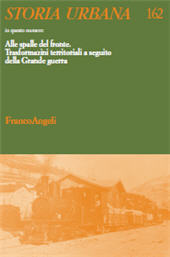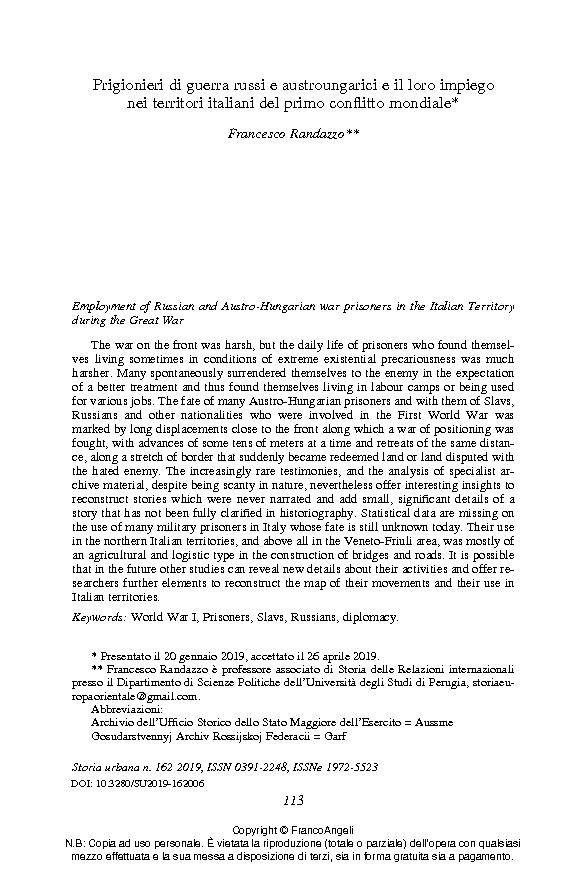Prigionieri di guerra russi e austroungarici e il loro impiego nei territori italiani del primo conflitto mondiale
113-128 p.
La guerra al fronte è dura, ma molto più dura è la vita quotidiana dei prigionieri che si ritrovano a vivere talvolta in condizioni di estrema precarietà esistenziale. Molti si consegnano spontaneamente al nemico nell'aspettativa di un trattamento migliore e si ritrovano così a vivere in campi di lavoro o a essere utilizzati per lavori vari. La sorte di molti prigionieri austroungarici e con loro di slavi, russi e altre nazionalità rima ste coinvolte nel primo conflitto mondiale è segnata da lunghi spostamenti a ridosso del fronte lungo il quale si combatte un guerra logorante di posizionamento con avanzamenti di poche decine di metri alla volta e ripiegamenti della stessa distanza. Lungo un tratto di confine che diventa a un tratto terra redenta oppure terra contesa all'odiato nemico. Le testimonianze, sempre più rare, e lo scavo di materiale d'archivio specialistico, pur nella sua esiguità, offrono tuttavia spunti interessanti per ricostruire storie mai narrate e aggiungono piccoli,
significativi dettagli di una storia non del tutto chiarita in sede storiografica. Mancano all'appello dati statistici sull'impiego di molti militari prigionieri in Italia della cui fine ancora oggi non si sa nulla. Il loro utilizzo nei territori italiani del nord, e soprattutto dell'area venetofriulana, è stato per lo più di tipo agricolo e logistico nella costruzione di ponti e strade. È possibile che in futuro altri studi possano svelarci nuovi dettagli sulle loro attività e offrire agli studiosi ulteriori elementi per ricostruire la mappa dei loro spostamenti e del loro utilizzo nei territori italiani. [Testo dell'editore].
The war on the front was harsh, but the daily life of prisoners who found themselves living sometimes in conditions of extreme existential precariousness was much harsher. Many spontaneously surrendered themselves to the enemy in the expectation of a better treatment and thus found themselves living in labour camps or being used for various jobs. The fate of many AustroHungarian prisoners and with them of Slavs, Russians and other nationalities who were involved in the First World War was marked by long displacements close to the front along which a war of positioning was fought, with advances of some tens of meters at a time and retreats of the same distance, along a stretch of border that suddenly became redeemed land or land disputed with the hated enemy. The increasingly rare testimonies, and the analysis of specialist archive material, despite being scanty in nature, nevertheless offer interesting insights to reconstruct stories which were never narrated and add small,
significant details of a story that has not been fully clarified in historiography. Statistical data are missing on the use of many military prisoners in Italy whose fate is still unknown today. Their use in the northern Italian territories, and above all in the VenetoFriuli area, was mostly of an agricultural and logistic type in the construction of bridges and roads. It is possible that in the future other studies can reveal new details about their activities and offer researchers further elements to reconstruct the map of their movements and their use in Italian territories. [Publisher's text].
-
Articoli dello stesso fascicolo (disponibili singolarmente)
-
Informazioni
Codice DOI: 10.3280/SU2019-162006
ISSN: 1972-5523
PAROLE CHIAVE
- Prima guerra mondiale, Prigionieri Slavi Russi, Diplomazia
- World War I, Prisoners, Slavs, Russians, diplomacy



